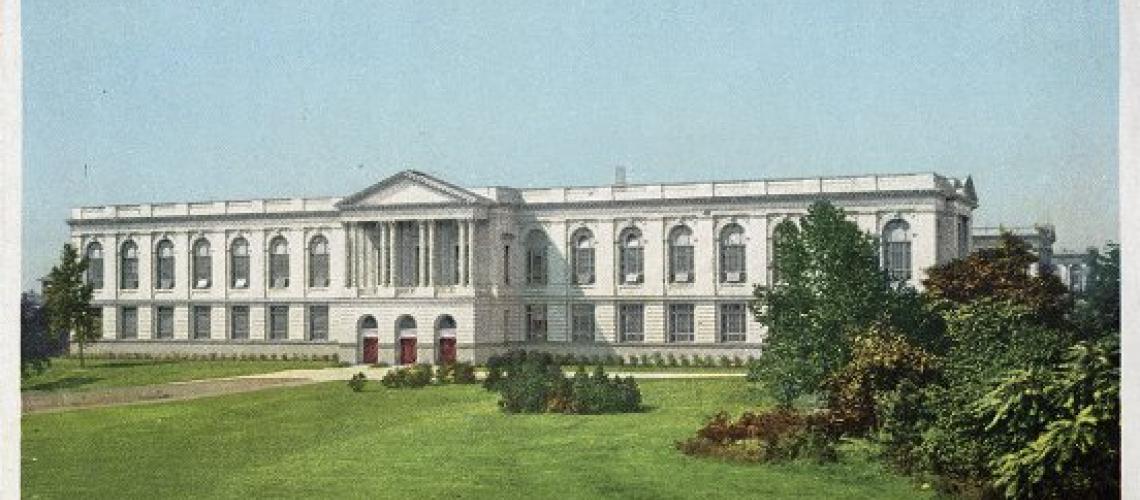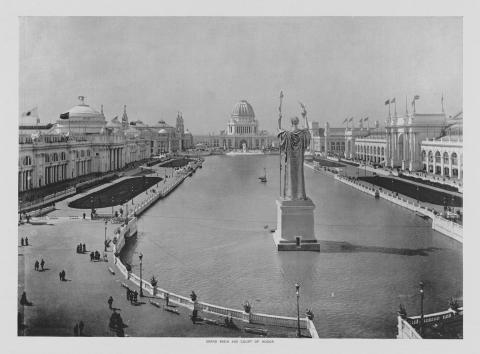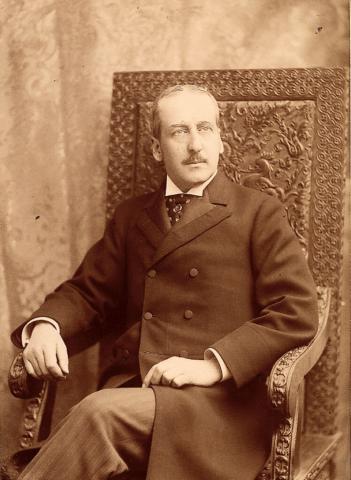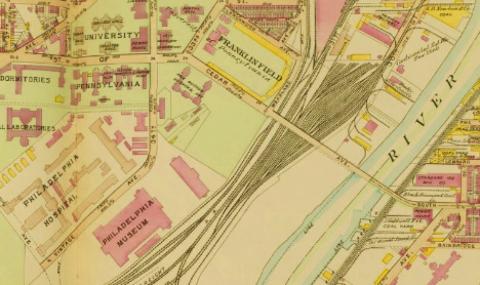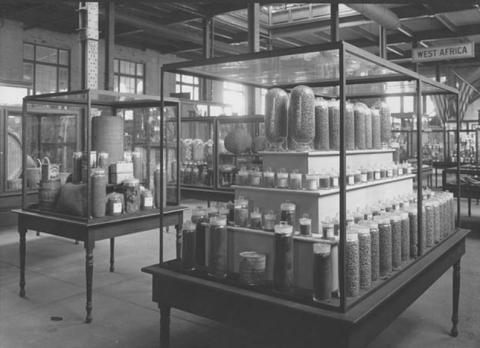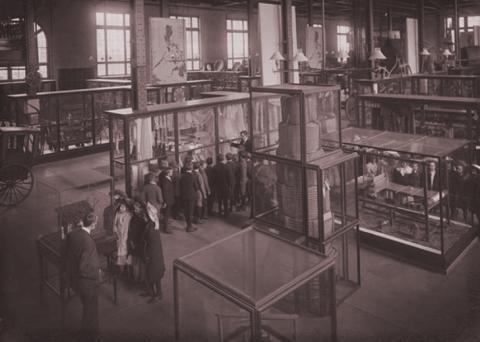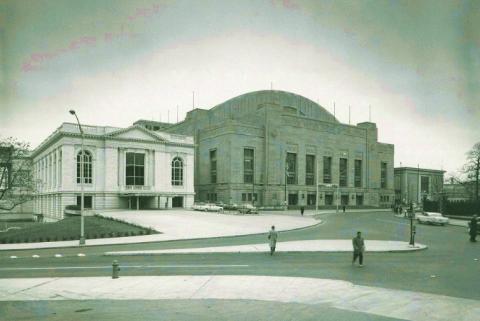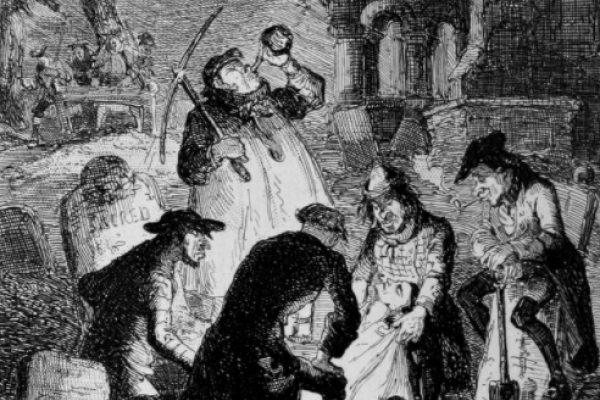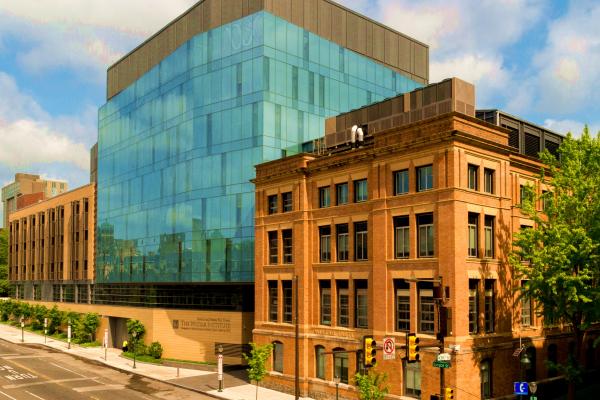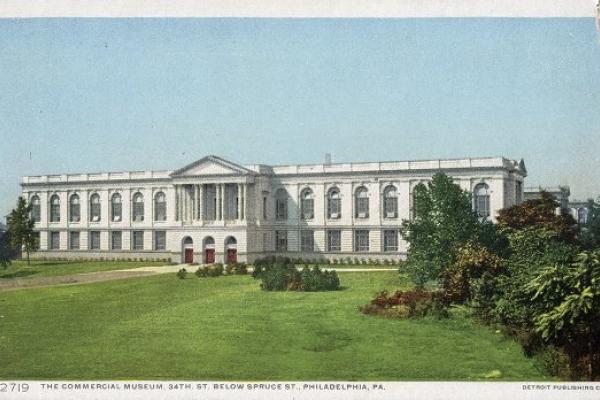The Commercial Museum: Exhibiting Capitalist Worlds in West Philadelphia
The Philadelphia Commercial Museum promoted the economic activities of Americans overseas through lavish exhibits and extensive libraries of information about markets, commodities, and economically relevant cultural practices abroad; its educational program served generations of twentieth century Philadelphia schoolchildren.
Occupying sixteen acres of land near the west bank of the Schuylkill River, on former grounds of the Blockley Almshouse, the Philadelphia Commercial Museum opened in 1899. Until its closing in 1982, with its extensive collection of foreign objects and information about foreign markets in one place, businesses that wished to sell goods overseas could access expertise and information crucial to their trade.
“An institution maintained by public appropriations and operated under the guidance of an International Advisory Board, made up of leading Chambers of Commerce and commercial organizations throughout the United States and in many other countries.
The object of the institution is to aid in the building up of the foreign trade of America.
The requirements of foreign markets are closely studied and reported; samples are secured of the most salable articles, and at the same time of the products offered in return. Shipping and custom-house regulations, current prices, best routes of shipment, etc., are fully reported. Merchants in all foreign countries are systematically investigated, direct and through intermediaries, with special reference to their fitness to undertake American business.
This work of the Museum is undertaken for the benefit of American manufacturers and merchants, from whom correspondence and inquiries are welcomed.”1
The industrial revolutions of the nineteenth century instigated technological, socioeconomic, and cultural changes that would fundamentally shape the modern world. Beginning in the middle of the nineteenth century, temporary “world’s fairs” or expositions in major European and American cities became the most prominent venues for new manufacturers of technological innovations to showcase their designs, from typewriters to locomotives. “Human zoos” and anthropological exhibits on colonized and exoticized peoples demonstrated the global scope and imperial intent of the fairs.2
Inspired by the menagerie of inventions, ideas, products, and people on display at the 1893 World’s Columbian Exposition in Chicago, William P. Wilson, a biology professor at the University of Pennsylvania, proposed an institution that would both inform and inspire entrepreneurs and businessmen across the United States. The unprecedented size of the 1893 Chicago exposition had demonstrated America’s burgeoning importance on the world stage, and Wilson recognized the value of these expositions in establishing American dominance in the international trade sphere. However, something more durable than a six-month world’s fair was required. With an extensive collection of foreign objects and information about foreign markets in one place, businesses that wished to sell goods overseas could access expertise and information crucial to their trade. Through the support of Penn’s Provost William Pepper, the medical director of the 1876 Centennial Exhibition in Philadelphia and a man determined to make Philadelphia the museum capital of the United States, Wilson purchased almost every exhibit displayed at the World’s Columbian Exposition, as well as objects from other foreign fairs, ranging from Guatemala to Liberia. With the proceeds of successful fundraising after the Columbian Exposition closing, Pepper and Wilson rented, for the next five years, an old Pennsylvania Railroad office building for displaying the exhibits, which required twenty-four railway cars to transport them from Chicago.3
Wilson’s vision, shared with Pepper, was a permanent museum that would be more than a “musty collection of specimens”—a museum that would entice the public with elaborate and dynamic visuals, including exhibits of clothing, instruments, tools, and other rare goods from across the world, brought together for the sole purpose of comparison and valuation. “It was Pepper’s idea to situate the University Museum [the Free Museum of Art and Science of the University of Pennsylvania, which was largely concerned with archaeology] near the Commercial Museum,” wrote a contributor to Popular Science Monthly. “To this end the City Councils, in 1896, passed an ordinance giving over to the trustees of the Commercial Museum sixteen acres of land for the construction of suitable buildings.”4
Constructed between 1897 and 1899, the Museum actually was a complex of four buildings, its design mirroring the neoclassical architecture of the 1893 Columbian Exposition. So central was the Museum to Philadelphia’s civic landscape that the 1900 Republican National Convention, which nominated William McKinley and Theodore Roosevelt, was hosted at the Museum.5
The Philadelphia Commercial Museum was created to promote the economic activities of Americans overseas through lavish exhibits and extensive libraries of information about markets, commodities, and economically relevant cultural practices abroad. Working with some forty governments abroad, the Museum facilitated connections between American entrepreneurs and foreign markets with the purpose of educating Americans on international trade. At its peak, the Commercial Museum was the leading institution authorized to collect and hold information regarding international commerce in the United States.6
“The Philadelphia Commercial Museum is endeavoring to increase foreign trade of the United States. . . with every nation of the world.”7
Unlike other museums in the city, the exhibits in the Commercial Museum showcased foreign objects relating to commerce. Wilson filled the exhibits with material acquired from expired fairs from over forty different countries. The Museum's collections included clothing, instruments, tools, and other rare goods from the Philippines, Africa, China, India, Mexico, and Latin America. Through these collections, Americans were to become knowledgeable about the economies of unfamiliar cultures and nations, as well as commodities and practices harkening to the dioramas and anthropological displays of the world’s fairs, no doubt in some cases reinforcing conventional stereotypes. For example, the cotton exhibit at the Commercial Museum included a life-size model of (according to the label on Museum’s photograph) “negro woman picking cotton.”8
Central to the Museum’s purpose, the Bureau of Information was formed to produce and collect information on foreign trade, and to make this information accessible to the general public. The Bureau provided economic information, including national statistical reports, official journals from foreign nations, and trading publications. The publications produced by the Bureau profiled countries by presenting statistical and anecdotal information to encourage Americans to establish trading relations with those nations. It was the sale of this information that provided much of the financial support for the Museum.9 Describing the importance of the Bureau, Wilson stated:
“It has served to give the businessmen of America an unusual opportunity to acquire, in a very short time, a great deal of information concerning the markets of the world; placing them in a position to compete successfully with those who, in the matter of experiences, have had an enormous advantage.”10
Beyond its economic aims, from its early years, the Commercial Museum focused on student outreach. Wilson himself conducted night classes to educate schoolteachers on how to teach using the Museum. A school trip to the Museum consisted of a presentation by a staff member on the global history and geography of commerce, a tour of the Museum’s collections and library, and a demonstration of the translation services it offered. For rural Pennsylvania schools unable to come to Philadelphia, Wilson packaged samples of textiles and raw materials to distribute to the students. In its later years, the Museum was closed to the general public, only allowing students to tour the building. The overwhelming number of schools forced the Museum to employ two full-time teachers to work as class instructors.11
By the end of the 1920s, the Museum's popularity and relevance had waned. Following Wilson’s death in 1926, the enterprise was unable to secure a successor of similar vision and zeal. Moreover, under Secretary Herbert Hoover, the U.S. Department of Commerce had taken on most of the Commercial Museum’s informational functions. The decisive blow came with the Great Depression, the worst economic downturn in the nation’s history, disrupting trade, consumption, and production. At this time, two of the four buildings of the Museum were demolished and an Art Deco style auditorium, later called the Philadelphia Civic Center, was built. This auditorium famously hosted political conventions: the Democratic National Convention in 1936 and 1948, the Republication National Convention in 1940 and 1948. As for the post-World War II Commercial Museum, it came to be regarded as a mere appendage of the Civic Center. Small-scale exhibitions were organized to revive the Museum, but with little effect. Global economic development, trade, and information exchange had dramatically changed, and, by the onset of the Cold War, the Museum no longer served a vital economic function. Despite the Museum’s faded exhibits and commercial obsolescence, its educational programs for schoolchildren continued apace. The Commercial Museum, Philadelphia’s brick and mortar paean to capitalism, was closed in 1982, ninety-nine years after the world’s fair that inspired it. The structure was demolished in 2005. Its collections were dispersed to other local museums, including the University of Pennsylvania Museum of Archaeology and Anthropology, the later name of the Free Museum of Science and Art built alongside the Commercial Museum but spared its fate.12
1. American Trade with Siam (Philadelphia: The Philadelphia Commercial Museum, 1898), p. 4.
2. Louise Krasniewicz, "All the World in One Place," Expedition Magazine, vol. 57, no. 1, 2015, pp. 7-14.
3. Katlyn A. Wolfram, “The Rise and Fall of the Philadelphia Commercial Museum: How a Forgotten Museum Forever Altered American Industry," Independence Seaport Museum, spring 2010, accessed from https://www.phillyseaport.org/rise-fall-philadelphia-commercial-museum, 1 December 2020; Steven Conn, “An Epistemology for Empire: The Philadelphia Commercial Museum, 1893-1926,” Diplomatic History 22 no. 4 (1998): 533–563; Edward Duffy, “The Making & Breaking of the Philadelphia Commercial Museum,” November 2018, Hidden City Philadelphia, accessed from https://hiddencityphila.org/2018/11/the-making-breaking-of-the-philadelphia-commercial-museum/.
4. Duffy, “Making & Breaking of the Philadelphia Commercial Museum”; Lewis R. Harley, “Sketch of Dr. William Pepper,” Popular Science Monthly, October 1899, pp. 840–841, accessed from books.google.com.
5. Duffy, “Making & Breaking of the Philadelphia Commercial Museum.”
6. Conn, “Epistemology for Empire,” 545–546.
7. William P. Wilson, cited in Conn, “Epistemology for Empire,” 533.
8. Casey Walsh, “Anthropology and the Commodity Form: The Philadelphia Commercial Museum,” Critique of Anthropology 32 no. 3 (September 2012): 223–240.
9. Conn, “Epistemology for Empire,” 545–547.
10. Wilson, cited in Conn, “Epistemology for Empire,” 546.
11. Wolfram, “Rise and Fall of the Philadelphia Commercial Museum.”
12. Duffy, “The Making & Breaking of the Philadelphia Commercial Museum”; Dwaune Latimer, “The People and Products of Colonization: Africa at the Paris and Chicago Expositions,” Expedition Magazine, vol. 57, no. 1, 2015, pp. 22–26.
